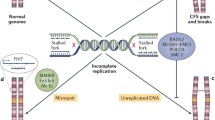Summary
In a study of the possible relationship between human fragile sites, chromosomal rearrangements related to neoplasia, and chromosome regions involved in evolutionary changes, we have found that 17 fragile sites related to cancer, 15 fragile sites not related to cancer, and 17 non-fragile regions also related to human malignancy correspond or are close to bands involved in rearrangements that have taken place during chromosomal evolution in primates.
Similar content being viewed by others
References
Berger R, Bloomfield CD, Sutherland GR (1985) Report of the committee on chromosome rearrangements in neoplasia and on fragile sites. (8th International Workshop on Human Gene Mapping) Cytogenet Cell Genet 40:490–535
Clemente IC (1984) Tesis de licenciatura. Universitat Autònoma de Barcelona
Dekaban A (1965) Persisting clone of cells with an abnormal chromosome in a woman previously irradiated. J Nucl Med 6:740–746
Dutrillaux B (1979a) Chromosomal evolution in primates: tentative phylogeny from Microcebus murinus (Prosimian) to man. Hum Genet 48:251–314
Dutrillaux B (1979b) Very large analogy of chromosome banding between Cebus capucinus (Platyrrhini) and man. Cytogenet Cell Genet 24:84–94
Dutrillaux B, Biemont MC, Viegas-Pequignot E, Laurent C (1979) Comparison of the karyotypes of four Cercopithecoidae: Papio papio, P. anubis, Macaca mulatta and M. fascicularis. Cytogenet Cell Genet 23:77–83
Dutrillaux B, Couturier J, Mulleris M, Lombard M, Chauvier G (1982) Chromosomal phylogeny of forty-two species or subspecies of Cercopithecoids (Primates Catarrhini). Ann Génét (Paris) 25:96–109
Guichaoua M, Mattei MG, Mattei JF, Giraud F (1982) Aspects genetiques des sites fragiles autosomiques. A propos de 40 cases. J Génét Hum 30:183–197
Jotterand-Bellomo M (1984) Les sites fragiles autosomiques. J Génét Hum 32:155–166
Miró R, Clemente IC, Caballín MR, Estop AM, Garcia M, Ponsà M, Fuster C, Genescà A, Egozcue J (1986) Aplicación de las técnicas de bandas de alta resolución al estudio de la evolución cromosómica en Primates. Serie memorias de eventos Científicos colombianos 43, ICFES, Bogotá (in press)
Motegi T, Komatsu M, Nakazoto Y, Ohuchi M, Minoda K (1982) Retinoblastoma in a boy with a de novo mutation of a 13/18 translocation: the assumption that the retinoblastoma locus is at 13q141 particularly at the distal portion of it. Hum Genet 60:193–195
Paris Conference (1971, Suppl 1975) Standardization in human cytogenetics. Cytogenet Cell Genet 15:201–238
Schmid M, Ott G, Haaf T, Scheres JMJC (1985) Evolutionary conservation of fragile sites induced by 5-azacytidine and 5-azadeoxycytitine in man, gorilla, and chimpanzee. Hum Genet 71:342–350
Seuanez HN, Evans HJ, Martin DE, Fletcher J (1979) An inversion of chromosome 2 that distinguishes between Bornean and Sumatran orangutans. Cytogenet Cell Genet 23:137–140
Shabtai F, Klar D, Hart J, Halbrecht I (1985) On the meaning of fragile sites in cancer risk and development. Cancer Genet Cytogenet 18:81–85
Stockholm Conference (1978) An international system for human cytogenetic nomenclature. (ISCN 1978) Cytogenet Cell Genet 21:383–395
Turleau C, de Grouchy J, Chavin-Colin F (1975) Inversion péricentrique du 3 homozygote et hétérozygote, et translation centromérique du 12 dans une famille d'orangs-outangs. Implications évolutives. Ann Génét (Paris) 18:227–233
Yunis JJ, Prakash O (1982) The origin of man: a chromosomal pictorial legacy. Science 215:1525–1530
Yunis JJ, Ramsay N (1978) Retinoblastoma and subband deletion of chromosome 13. Am J Dis Child 132:161–163
Yunis JJ, Soreng AL (1984) Constitutive fragile sites and cancer. Science 226:1199–1204
Author information
Authors and Affiliations
Rights and permissions
About this article
Cite this article
Miró, R., Clemente, I.C., Fuster, C. et al. Fragile sites, chromosome evolution, and human neoplasia. Hum Genet 75, 345–349 (1987). https://doi.org/10.1007/BF00284105
Received:
Revised:
Issue Date:
DOI: https://doi.org/10.1007/BF00284105




